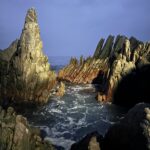Our most frequently asked questions.
The Northern Lights, or Aurora Borealis, are caused by charged particles from the sun colliding with gases in Earth’s upper atmosphere. When these solar particles interact with oxygen and nitrogen high above the planet, they create vivid displays of colour that dance across the polar skies.
- Green lights are produced by oxygen at lower altitudes.
- Red and pink hues occur when oxygen interacts higher up.
- Blue and violet tones come from nitrogen.
It’s a breathtaking natural phenomenon and witnessing it in person is something every photographer and traveller should experience at least once. View and join our next 7 night Lofoten Photo Tour here.
This article, “Best Apps to Track the Aurora Lights Forecast in Norway”, offers an overview of the top Northern Lights (aurora) tracking and northern lights tracker / forecasting apps and services, particularly useful for those visiting Norway or chasing auroras across Northern latitudes.
It reviews features like real-time solar activity, geomagnetic indices, visibility maps, and alert systems. Our recent blog also suggests the ideal months for aurora viewing (October to March) and encourages syncing northern lights tracker apps predictions with on-the-ground conditions and cloud cover. Find out more here.
Yes, Lofoten is safe year-round. Winter roads are well-maintained and cars come with studded tires. Visitors should drive cautiously and prepare for icy conditions, but services and accommodation remain open all winter.
While buses connect the main towns, having a car is highly recommended. It allows flexibility for photography stops, chasing aurora, and reaching remote beaches and villages.
The quickest route is to fly from Oslo to Bodø, then take a short flight to Svolvær or Leknes. Alternatively, you can take the Bodø–Moskenes ferry or fly into Harstad/Narvik (Evenes) and drive the E10 road into the islands.
October and February–March are ideal months for photographers, offering dramatic light, snow-capped peaks, and higher chances of clear skies for aurora chasing.
Yes, Lofoten is one of the best places in Norway to see the Northern Lights. The aurora season runs from late August to mid-April, with the strongest displays usually between September and March. Find out more about the best times to go and the Northern Lights Forecast here.
Lofoten can be pricey compared to mainland Norway. Expect higher accommodation and food costs, but budget travelers can save by cooking in cabins and booking transport in advance.
While renting a car is best for flexibility, you can travel by local buses, ferries, and Hurtigruten coastal ships. Taxis and private transfers are also available.
For Northern Lights photography, visit between September and April. For the Midnight Sun and endless daylight, plan a trip between late May and mid-July.
Most travelers recommend 4–7 days to see the main highlights, including Reine, Hamnøy, Nusfjord, Henningsvær, and Å. Photographers often stay longer to increase their chances of clear skies for the Northern Lights.
Absolutely. Lofoten is considered one of the most beautiful places in the world, offering dramatic mountains, fjords, white-sand beaches, and cultural fishing villages. Whether you’re interested in photography tours, hiking, or simply experiencing Arctic Norway, Lofoten is worth every moment.



